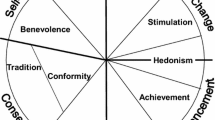Abstract
The purpose of the present study is to extend previous research investigating personality factors as determinants of financial risk taking in everyday money matters (e.g., personal investments and household affairs). Type A and Type B subjects were asked to make a series of everyday financial decisions that varied in degree of risk. Type A individuals took greater financial risks than Type B individuals. The results provide additional support for the influence of personality factors in everyday financial risk-taking behavior and demonstrated another area of risk taking associated with the Type A behavior pattern not previously identified.
Similar content being viewed by others
REFERENCES
American Psychological Association. (1992). Ethical principles of psychologists and code of conduct. American Psychologist, 47, 1597–1611.
Becker, G. S. (1976). The economic approach to human behavior. Chicago: University of Chicago Press.
Boone, L., & Kurtz, D. L. (1989). Personal finance management. Homewood, IL: Irwin.
Carver, C. S., Coleman, E. A., & Glass, D. C. (1976). The coronary-prone behavior pattern and the suppression of fatigue on a treadmill test. Journal of Personality and Social Psychology, 33, 460–466.
Friedman, M., & Rosenman, R. H. (1974). Type A behavior and your heart. New York: Knopf.
Haynes, S. G., & Matthews, K. A. (1988). The association of Type A behavior with cardiovascular disease-update and critical review. In B. K. Houston & C. R. Snyder (Eds.), Type A behavior pattern: Research, theory, and intervention (pp. 51–82). New York: John Wiley & Sons.
Houston, B. K., & Snyder, C. R. (Eds.). (1988). Type A behavior pattern: Research, theory, and intervention. New York: John Wiley & Sons.
Howard, J. H., Cunningham, D. A., & Rechnitzer, P. A. (1977). Work patterns associated with Type A behavior: A managerial population. Human Relations, 30, 825–836.
Jenkins, C. D., Zyzanski, S. J., & Rosenman, R. H. (1971). Progress toward validation of a computer-scored test for the Type A coronary-prone behavior pattern. Psychosomatic Medicine, 33, 193–201.
Lovallo, W. R., Pincomb, G. A., Edwards, G. L., Brackett, D. J., & Wilson, M. F. (1986). Work pressure and the Type A behavior pattern exam stress in male medical students. Psychosomatic Medicine, 48, 125–133.
Mettlin, C. (1976). Occupational careers and the prevention of coronary-prone behavior. Social Science and Medicine, 10, 367–372.
Price, V. A. (1982). Type A behavior pattern: A model for research and practice New York: Academic Press.
Ray, J. J., & Brozek, R. (1980). Dissecting the A-B personality type. British Journal of Medical Psychology, 53, 378–381.
Sorensen, G., Jacobs, D. R., Pirie, P., Folsom, A., Luepker, P., & Gillum, R. (1987). Relationship among Type A behavior, employment experience, and gender: The Minnesota Heart Survey. Journal of Behavioral Medicine, 10, 323–336.
Strube, M. J. (Eds.). (1991). Type A behavior. Newbury Park, CA: Sage.
Thoresen, C. E., & Low, K. G. (1990). Women and the Type A Behavior Pattern: Review and commentary. Journal of Social Behavior and Personality, 5, 117–133.
Van Egeren, L. F., Sniderman, L. D., & Roggelin, M. S. (1982). Competitive two-person interactions of Type-A and Type-B individuals. Journal of Behavioral Medicine, 5, 55–66.
Weidner, G., & Matthews, K. A. (1978). Reported physical symptoms elicited by unpredictable events and the Type A coronary-prone behavior pattern. Journal of Personality and Social Psychology, 36, 1213–1220.
Widicus, W. W., & Stitzel, T. E. (1989). Personal investing (5th ed.). Homewood, IL: Irwin.
Wong, A., & Carducci, B. J. (1991a, March). Gender differences in financial risk aversion in everyday money matters. Poster session presented at the meeting of the Southeastern Psychological Association, New Orleans.
Wong, A., & Carducci, B. J. (1991b). Sensation seeking and financial risk taking in everyday money matters. Journal of Business and Psychology, 5, 525–530.
Zuckerman, M. (Ed.) (1983). Biological biases of sensation seeking, impulsivity, and anxi-ety. Hillsdale, NJ: Lawrence Erlbaum Associates, Publishers.
Zuckerman, M., & Kuhlman, D. M. (1978, August). Sensation seeking and risk taking in response to hypothetical situations. Paper presented at the meeting of the Interna-tional Association of Applied Psychology, Munich, Germany.
Author information
Authors and Affiliations
Rights and permissions
About this article
Cite this article
Carducci, B.J., Wong, A.S. Type a and Risk Taking in Everyday Money Matters. Journal of Business and Psychology 12, 355–359 (1998). https://doi.org/10.1023/A:1025031614989
Issue Date:
DOI: https://doi.org/10.1023/A:1025031614989




